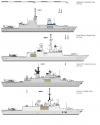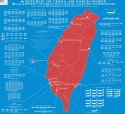Taiwan is reportedly pushing ahead with plans to upgrade its indigenous anti-ship and air-to-air missile arsenal, while the development status of its land attack cruise missiles remains uncertain.
Media reports in Taiwan say the island's National Chung-Shan Institute of Science and Technology, or NCSIST, is currently working to improve the range, guidance systems and electronic counter-countermeasures of the Hsiung-Feng (Brave Wind) series of anti-ship missiles, the Tien Kung (Sky Bow) surface-to-air missile and the Tien Chien (Sky Sword) II air-to-air missile. No timelines or specific details have been given for the various programs.
The reports say NCSIST has successfully increased the range of the subsonic Hsiung-Feng II and ramjet-powered Hsiung-Feng III anti-ship missiles to 156 and 250 miles respectively. Both types of missiles are deployed by the Taiwanese armed forces in the road mobile and shipboard versions.
The HF-3 is an inertial navigation system-guided missile with terminal active radar homing. It uses a 500-pound explosively-formed projectile fragmentation warhead and is reportedly equipped with a smart fuse designed to direct most of the explosive energy downward once it has detected that the missile is inside the target ship's hull.
In the event of a cross-strait conflict with China, the HF-3 will be Taiwan’s most advanced anti-ship missile to be fielded against the rapidly modernizing People’s Liberation Army Navy and will almost certainly be used to target the PLAN’s high-value warships, such as its aircraft carriers and Type 055 cruisers.
Development is also reportedly underway to increase the range of the Tien Chien II radar-guided air-to-air missile to 56 miles. Taiwan has recently completed an upgrade program to its Aerospace Industrial Development Corporation F-CK-1 Indigenous Defense Fighter, which among other improvements allows it to carry four TC-2 air-to-air missiles, up from the current two. A naval variant, designated the TC-2N, is fitted on Taiwanese Navy ships for defense against aircraft and anti-ship missiles.
The Tien Kung III medium- to long-range surface-to-air missile will also be in line for an upgrade. First fielded in 2011, the TK III also has the capability to intercept tactical ballistic missiles and is deployed alongside the U.S. Raytheon MIM-104 Patriot, with early warning against incoming ballistic missiles provided by a Raytheon AN/FPS-115 PAVE Phased Array Warning System, or Pave Paws, which entered service in 2013.
Pave Paws is a Cold War-era radar and computer system developed to "detect and characterize a sea-launched ballistic missile attack" that first became operational in the U.S. in 1980. Taiwan acquired a single system, which became operational in 2013. Stationed in Hsinchu County in northern Taiwan, it is claimed to have a range of 3,100 miles and gives a six-minute warning of an impending missile attack.
Raytheon was awarded a $26 million U.S. Department of Defense contract in November 2016 to upgrade the system for Taiwan “to address obsolescence concerns," with work expected to be complete by the middle of 2018. The company had previously won a $289.5 million contract to provide sustainment support for the radar in 2012.
Taiwan also has offensive land attack cruise missiles and standoff weapons known to be either in service or under development. NCSIST has been working on a ground-launched land attack cruise missile since 2001, which has been reported to have been cleared for production in 2011. The HF-2E (not related to the HF-2 anti-ship missile mentioned above) is claimed to be a subsonic missile capable of delivering a 440-pound unitary warhead up to 375 miles away.
In 2014, Taiwan unveiled the Wan Chien (Ten Thousand Swords) standoff weapon for its upgraded F-CK-1 aircraft. As its name suggests, the Wan Chien is a delivery system for submunitions, with its unpowered, streamlined dispenser reportedly having a range of up to 135 miles.
Taiwan’s extensive indigenous defense industry is a result of a highly successful effort by China to diplomatically isolate the island, and has in the past successfully lobbied hard to restrict any significant arms sales to Taiwan.
China sees Taiwan as a renegade province and does not recognize the island as a sovereign nation. The U.S officially abides by the "One China” policy, but does not recognize China’s sovereignty over Taiwan nor does it recognize Taiwan as a sovereign country.
The U.S. does, however, maintain strong de facto diplomatic relations with Taiwan’s government, and the Taiwan Relations Act enacted by Congress in 1979 commits the United States to “make available to Taiwan such defense articles and defense services in such quantity as may be necessary to enable Taiwan to maintain a sufficient self-defense capability."






